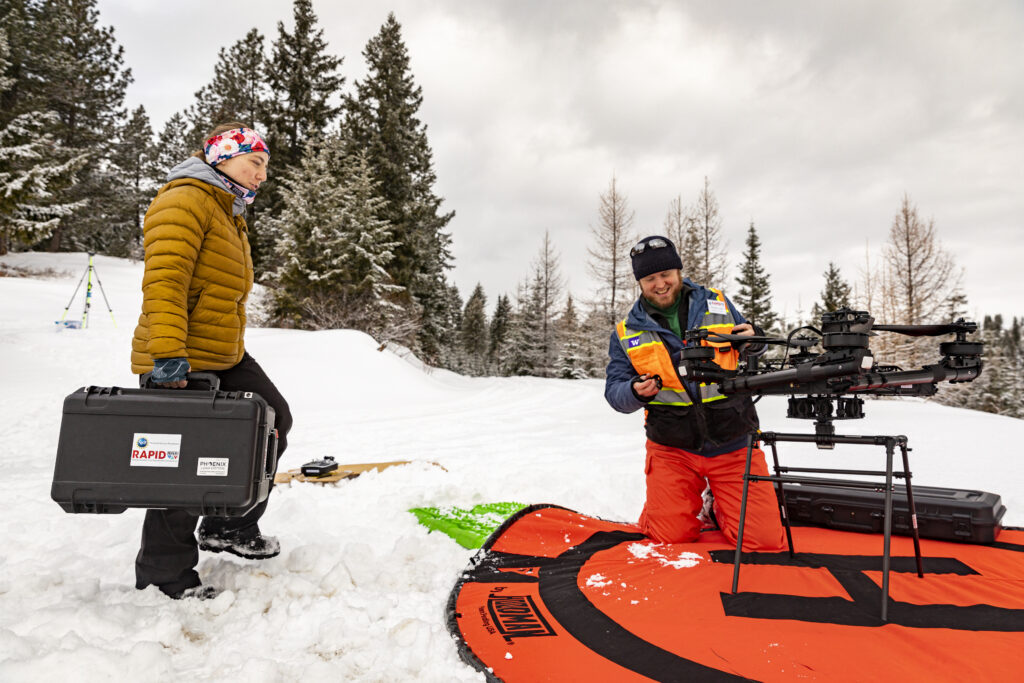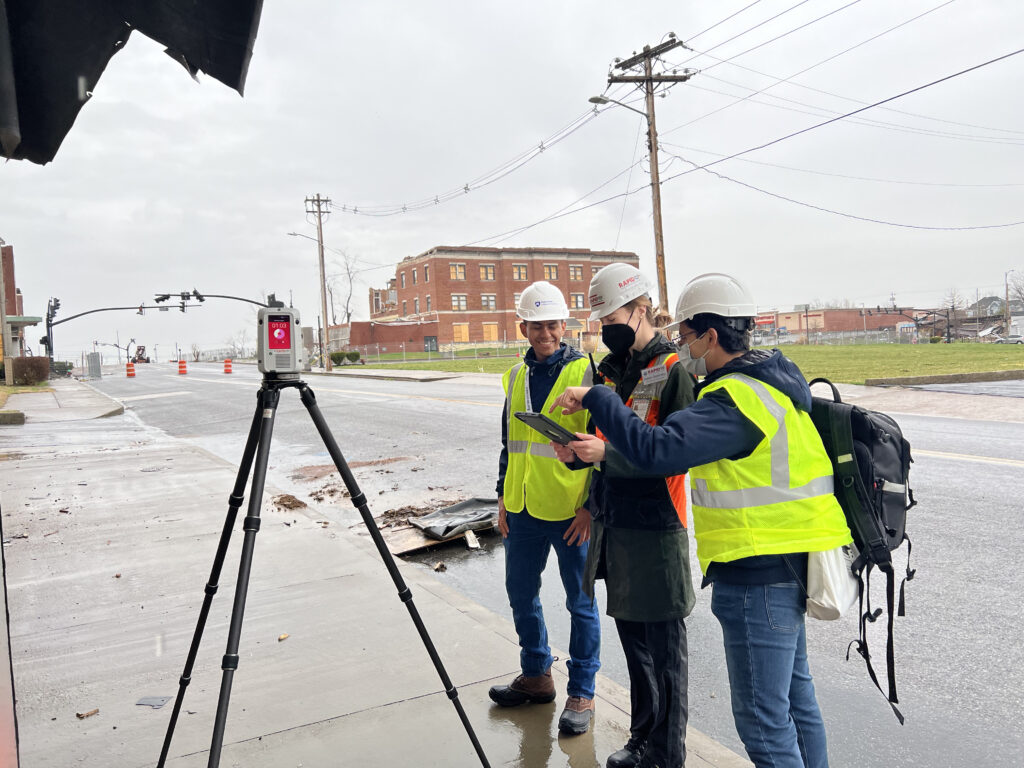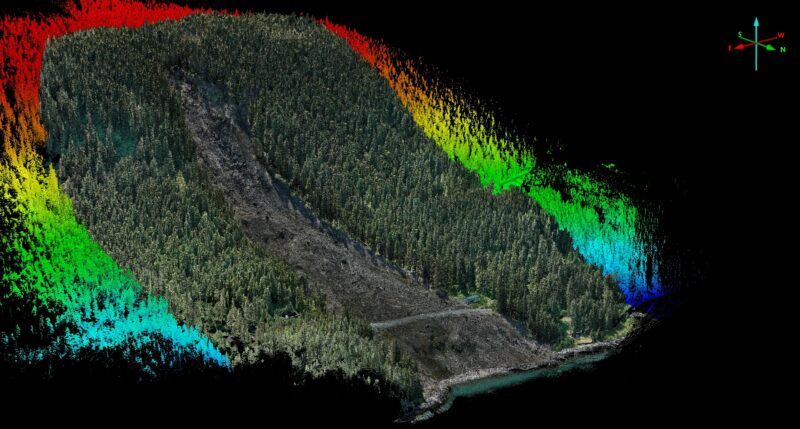The role of laser scanning in shaping our resiliency to natural hazards
Would you believe me if I told you that there is a real-life geomatics version of Indiana Jones? These quiet professionals specialize in laser scanning instead of archaeology, and their “Holy Grail” is data.
The Natural Hazard and Disaster Reconnaissance Facility (RAPID) helps researchers utilize lidar sensors to comprehensively scan and document the aftermath of natural disasters. If you are unfamiliar with this groundbreaking program let me introduce you to the group that uses geomatics to support science to make the world a better place.

Data collection in Death Valley National Park following Hurricane Hilary. An array of terrestrial lidar scanners, including the Leica RTC360 (pictured), were used to capture damage from the extraordinary precipitation event.
In the face of escalating natural disasters, it has never been more critical for advanced research into infrastructure to bolster community resilience. The RAPID facility, part of the Natural Hazards Engineering Research Infrastructure (NHERI), is spearheading innovative approaches to comprehend, respond to, and recover from various natural hazards. This collaborative effort, funded by the National Science Foundation (NSF), brings together experts from diverse disciplines to create a comprehensive and groundbreaking strategy for natural hazards engineering.
Overview of the NHERI Program
The RAPID is part of the broader NHERI initiative, which addresses a spectrum of natural hazards. These hazards include earthquakes, hurricanes, tornadoes, wildfires, and other extreme events that threaten infrastructure and community resilience. NHERI aims to develop a holistic understanding of natural hazards and their impact on the built environment.
Among their objectives are:
Rapid Response Research: The primary goal of the RAPID is to facilitate swift, on-the-ground research immediately following natural hazard events. By deploying interdisciplinary teams equipped with state-of-the-art equipment and tools, researchers aim to gather critical data that can inform future engineering practices and improve building codes.
Hybrid Simulation Techniques: Hybrid simulation combines experimental testing with advanced computational models, allowing researchers to better understand the complex interactions between structures and various natural hazards. The NHERI program leverages hybrid simulation techniques to simulate real-world scenarios, providing valuable insights into failure mechanisms and vulnerabilities in the natural and built environments.
 Community Resilience Enhancement: Beyond the technical aspects, the program also focuses on enhancing community resilience. By integrating social and economic factors into their research, the RAPID seeks to develop holistic solutions that consider the broader impact of natural hazards on communities.
Community Resilience Enhancement: Beyond the technical aspects, the program also focuses on enhancing community resilience. By integrating social and economic factors into their research, the RAPID seeks to develop holistic solutions that consider the broader impact of natural hazards on communities.
Education and Outreach: The program places a strong emphasis on education and outreach, aiming to disseminate knowledge and best practices to various stakeholders, including engineers, policymakers, and the public. This educational component is crucial to fostering a culture of preparedness and informed decision-making.
I recently got to sit down with Michael Grilliot, Ph.D., the operations manager for the RAPID facility at the University of Washington, to get a better understanding of the program and its purpose. During the interview I inquired as to his favorite part of what they do. He responded with enough conviction and sincerity that you could feel it in the room.
“We’re doing this exciting work and all these really cool projects that have an honest and meaningful impact,” Grilliot said. “All these disasters that we’re going to, all of these buildings that we’re scanning, all of this data gets processed and analyzed for one reason. To just try and build it better. And you know all of the projects that get published are going to be helpful.”
Unique use of Lidar
The utilization of lidar technology within the RAPID facility plays a pivotal role in enhancing the precision and efficiency of data collection, particularly in the context of natural hazards such as earthquakes. Here are some key aspects of how lidar is employed within the program:

Researchers using the Leica RTC360 LiDAR scanner in Mayfield, Kentucky, following the 2021 Western Kentucky Tornado. The data was used to create digital twins and model tornado loading on historic masonry buildings.
High-Resolution Mapping: Lidar technology provides a rapid and high-resolution mapping of the earth’s surface. This is particularly valuable for assessing the impact of natural hazard events on infrastructure, terrain, and the built environment. The ability to create detailed 3D maps allows researchers to visualize and analyze the effects of natural hazards on structures and landscapes.
Structural Damage Assessment: Lidar is instrumental in conducting detailed structural damage assessments after natural hazard events. By quickly capturing precise images of affected buildings and infrastructure, researchers can identify areas of damage, assess the severity, and understand failure mechanisms. This information is crucial for improving building codes and designing structures with enhanced seismic resilience.
Terrain and Landscape Analysis: Beyond structural assessments, lidar technology aids in analyzing changes to the existing landscape caused by natural hazards. This includes the identification of fault lines, landslides, and other geological alterations. Understanding these changes contributes to a comprehensive understanding of the broader impact of earthquakes on the environment.
Rapid Response Capabilities: One of the strengths of lidar technology is its rapid data acquisition capabilities. In the aftermath of a natural hazard, quick response and data collection are essential. Lidar allows researchers to efficiently gather information, aiding in the timely assessment of damage and informing emergency response efforts.
Simulation and Modeling Support: Lidar data serves as a valuable input for simulation and modeling activities within the RAPID facility. By integrating lidar-generated 3D maps into computational models, researchers can simulate the effects of natural hazards more accurately. This enhances the reliability of predictions regarding structural behavior and vulnerabilities in the face of natural events.
Multi-Hazard Applications: the versatility of lidar technology allows its application across various natural hazards. Whether assessing hurricane damage or analyzing tornado impact zones, lidar’s ability to quickly generate detailed topographic information proves invaluable for multi-hazard resilience research.
Long-Term Monitoring: Lidar technology facilitates long-term monitoring of changes to the built environment. Continuous monitoring of structural stability and landscape alterations over time provides valuable data for understanding the long-term impacts of natural hazards and improving resilience strategies.
The toolkit available to RAPID professionals is broad, and laser scanners represent only one aspect of it. Andrew Lyda, an engineer involved in RAPID operations, said, “The appeal lies in the diversity of equipment. It’s not confined to laser scanners alone. We engage with total stations, survey instruments, as well as specialized gear for geo-technical, coastal, and marine purposes.”

3D model of a catastrophic landslide that occurred in Haines, Alaska. The underlying point cloud was created using data from the Phoenix Mini Ranger aerial lidar system and partially colorized with RGB from images captured with the Trinity F90+ fixed-wing UAS.
Collaborative Efforts and Educational Partnerships
The success of the NHERI program relies on collaboration among researchers, engineers, emergency responders, and community leaders. Partnerships with academic institutions play a crucial role in achieving program objectives.
The RAPID facility, based at the University of Washington, is a collaboration between the UW, Oregon State University, Virginia Tech, and the University of Florida, where researchers and students contribute their expertise to advance multi-hazard resilience. Some students who have contributed have moved on to PhD studies, reaching as far as Nepal. The researchers are excited to see that a few students have come full circle and are preparing to become faculty members.
Impact and Future Directions
Since its inception, the RAPID facility has made significant strides in advancing natural hazards engineering research. The integration of lidar technology and a broader multi-hazard focus enhances the precision and efficiency of data collection, providing researchers with a comprehensive understanding of various natural hazards.
Looking ahead, the program aims to further refine its methodologies, expand its network of collaborators, and develop innovative technologies to improve multi-hazard resilience. The goal is to create a more resilient built environment that can withstand and recover from a spectrum of natural disasters, ultimately saving lives and reducing the economic impact of these events.
The NHERI network, including the RAPID facility, is a beacon of progress in natural hazards engineering research. By combining rapid response capabilities, cutting-edge simulation techniques, and the innovative use of lidar technology, the program is making invaluable contributions to our understanding of various natural hazards and their impact on infrastructure and communities.
As the program continues to evolve, its findings will play a crucial role in shaping the future of disaster resilience and engineering practices in hazard-prone regions. When I started digging into this program, I approached it as if it was just a fascinating use of laser scanning. What I found is a group of people who appreciate lidar and laser scanning but have a true passion for helping us build a better world. Their efforts will ensure that our future will be less hazardous and more resilient to a world that is constantly trying to tear itself apart.
Mack Kowalski has more than 16 years of experience in layout management and laser scanning to provide innovative solutions and services to our clients and partners. His passion to push the boundaries of technology and delivering high-quality results in every project led him to co-found LiDAholics consulting firm.

